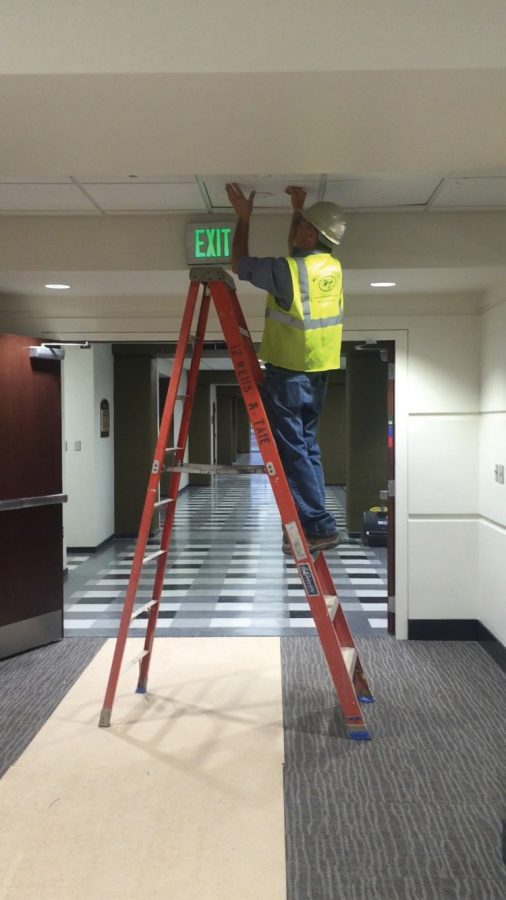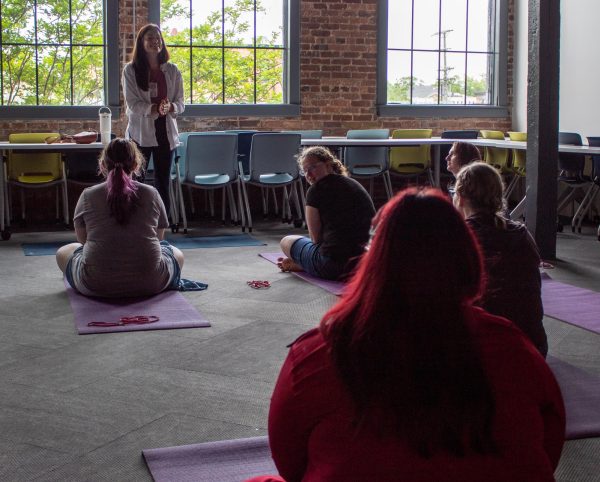McGee: ‘microscopic changes’ remain on science building construction
March 19, 2015
Construction of the new science building is nearly complete.
Assistant Vice President of Facilities Administration and Planning Michael Gautney said the building should be ready for move-ins to begin by April 1.
“Right now, we’re focusing on small maintenance repairs,” said project manager Jim McGee. “Repainting, cleaning and making microscopic changes within the building is what we’re focusing on. We’re mostly fine tuning.”
Vice President for Business and Financial Affairs Clinton Carter said the official opening date is May 1.
Inside, workers are spread throughout the five floors sweeping, painting and crossing tasks off their final checklists.
“The building is longer than a football field,” McGee said. “So communication is important in these final days, as it can get tiresome to move in the building if there are mistakes made.”
The nearly $40 million, 162,000 square foot facility houses 40 classrooms and laboratories, 42 faculty offices, 15 designated research rooms, three areas of refuge, and one tornado shelter. Many of the labs will be “teaching-laboratories” to increase classroom space. There are two auditorium-style classrooms and a large computer lab on each floor.
Floyd Hall, which currently houses the sciences, contains 43 classrooms. Human Environmental Sciences classes are also held in those spaces
Chemistry and Industrial Hygiene Department Chair Brentley Olive said the larger labs are safer for occupants.
“Some of our labs in Floyd are so small that two students cannot pass each other in the aisles,” Olive said. “We’ll also be able to store more equipment in those labs. We won’t have to go around to several labs to get what we need. The bigger labs will be much safer and will save us time.”
A new building with new equipment and state-of-the-art facilities will usher in a new era of competition for UNA against other universities.
“Scientific technology updates rapidly and other universities can get the newest technologies,” said biology major Sarah Tingle. “However, I know I’ve personally had to skip certain labs in many classes because we did not have the proper equipment for the lab or our equipment was so old or outdated that it wouldn’t work right for the lab.”
Tingle said new equipment could potentially help students land a job.
“Sometimes knowing how to run a specific test or operate a specific machine lands a job,” she said.
The new building will be one of the more progressive buildings on campus, McGee said. The air is removed through the roof of the building, which serves the community on lower levels so as to not expose them to harsh or hazardous chemicals.
“The building uses a ventilation system that pressurizes air so it can be contained to a certain space, which could potentially protect students if a hazardous gas was in the air,” McGee said.
Earth Science Department Chair Brenda Webb said she is excited to move into the new building.
“The new equipment and open space creates a positive environment where students and professors will be excited,” Webb said.
She said she is most excited about the lab spaces.
“We’ll be able to do some exciting things in those labs that we haven’t had space to do previously,” she said.
McGee said the department chairs of the Science and Technology Department had the opportunity to shape the layout of the new building.
“While we were making plans for the building, we consulted with the professors from each department and asked them what they needed most within a new building — what would help them teach more effectively,” he said, “This greatly helped the formation of the floors of each level. It actually worked out pretty well, and they all ended up being very organized.”
Olive said the professors began consulting with professional lab designers two years ago.
“I’m very glad we worked with the lab designers,” Olive said. “We told them our needs and they helped us get the equipment we needed. I don’t think the labs would be near as good as they are without their help. They kept us in the loop throughout the whole process.”











